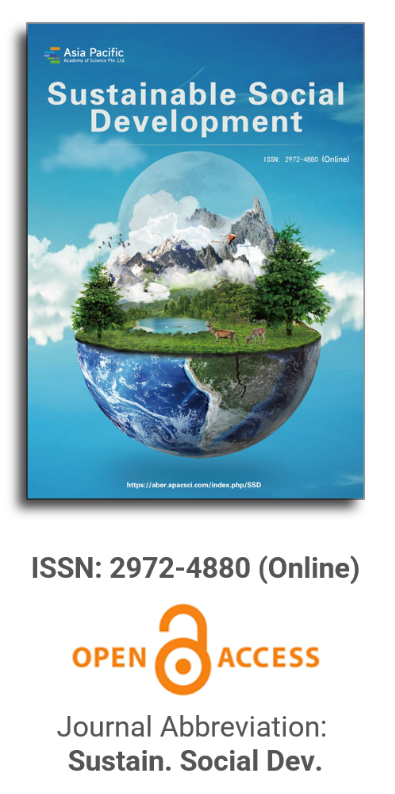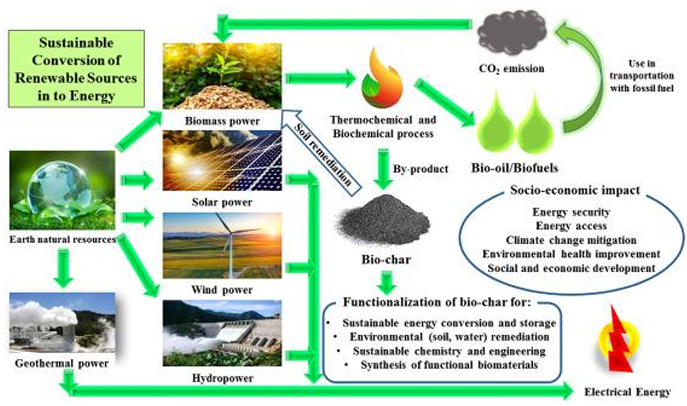
Asia Pacific Academy of Science Pte. Ltd. (APACSCI) specializes in international journal publishing. APACSCI adopts the open access publishing model and provides an important communication bridge for academic groups whose interest fields include engineering, technology, medicine, computer, mathematics, agriculture and forestry, and environment.

Environment, social and governance in sustainable agricultural practices in developing countries: A short note
Vol 1, Issue 3, 2023
Download PDF
Abstract
This review paper highlights the importance of environment, social and governance (ESG) in sustainable agricultural practices in developing countries. The importance of incorporating an environmental perspective has been discussed. The enhanced sustainable crop farming practices under ESG are precision agriculture technology, controlled environment agriculture, improving crop breeding, agricultural biotechnology, packaging innovation and coatings, reducing food waste, and regenerative agricultural practices. The green-minded leadership model should stem from this concept of ESG in sustainable agricultural practices in developing countries.
Keywords
References
- Principles for Responsible Investment. The SDG investment case. Available online: https://www.unpri.org/sustainable-development-goals/the-sdginvestment-case/303.article (accessed on 6 December 2023).
- Janah OO, Sassi H. The ESG impact on corporate financial performance in developing countries: A systematic literature review. International Journal of Accounting, Finance, Auditing, Management and Economics 2021; 2(6): 391–410.
- Liu M, Luo X, Lu WZ. Public perceptions of environmental, social, and governance (ESG) based on social media data: Evidence from China. Journal of Cleaner Production 2023; 387: 135840. doi: 10.1016/j.jclepro.2022.135840
- Singhania M, Saini N. Institutional framework of ESG disclosures: comparative analysis of developed and developing countries. Journal of Sustainable Finance & Investment 2021; 13(1): 516–559. doi: 10.1080/20430795.2021.1964810
- Lee K, Cin BC, Lee EY. Environmental responsibility and firm performance: The application of an environmental, social and governance model. Business Strategy and the Environment 2014; 25(1): 40–53. doi: 10.1002/bse.1855
- Waddock SA, Graves SB. The corporate social performance–financial performance link. Strategic Management Journal 1997; 18(4): 303–319.
- Weber O. Environmental, social and governance reporting in China. Business Strategy and the Environment 2013; 23(5): 303–317. doi: 10.1002/bse.1785
- Chauhan Y, Kumar SB. Do investors value the nonfinancial disclosure in emerging markets? Emerging Markets Review 2018; 37: 32–46. doi: 10.1016/j.ememar.2018.05.001
- Kiriu T, Nozaki M. A text mining model to evaluate firms’ ESG activities: An application for Japanese firms. Asia-Pacific Financial Markets 2020; 27(4): 621–632. doi: 10.1007/s10690-020-09309-1
- Baraibar-Diez ED, Odriozola M. CSR committees and their effect on ESG performance in UK, France, Germany, and Spain. Sustainability 2019; 11(18): 5077. doi: 10.3390/su11185077
- Ritchie H, Rodés-Guirao L, Mathieu E, et al. Population growth. Available online: https://ourworldindata.org/population-growth (accessed on 1 October 2023).
- Ritchie H, Roser M, Rosado P. CO2 and greenhouse gas emissions. Available online: https://ourworldindata.org/co2-and-greenhouse-gas-emissions (accessed on 1 October 2023).
- Daroshka V, Aleksandrov I, Fedorova M, et al. Agriculture and ESG transformation: Domestic and foreign experience of green agribusiness finance. In: Beskopylny A, Shamtsyan M, Artiukh V (editors). XV International Scientific Conference “INTERAGROMASH 2022”. Springer; 2023. pp. 2357–2368. doi: 10.1007/978-3-031-21219-2_264
- Zeng L, Jiang X. ESG and corporate performance: Evidence from agriculture and forestry listed companies. Sustainability 2023; 15(8): 6723. doi: 10.3390/su15086723
- Buallay A. Sustainability reporting and agriculture industries’ performance: Worldwide evidence. Journal of Agribusiness in Developing and Emerging Economies 2021; 12(5): 769–790. doi: 10.1108/jadee-10-2020-0247
- Hrebicek J, Popelka O, Štencl M, Trenz O. Corporate performance indicators for agriculture and food processing sector. Acta Universitatis Agriculturae et Silviculturae Mendelianae Brunensis 2013; 60(4): 121–132. doi: 10.11118/actaun201260040121
- Hrebicek J, Soukopova J, Stencl M, Trenz O. Integration of economic, environmental, social and corporate governance performance and reporting in enterprises. Acta Universitatis Agriculturae et Silviculturae Mendelianae Brunensis 2014; 59(7): 157–166. doi: 10.11118/actaun201159070157
- Ritschelova I, Sidorov VE, Hajek M, Hrebicek J. Corporate environmental reporting in the Czech Republic and its relation to environmental accounting at macro level. In: Proceedings of the 11th Annual EMAN Conference on Sustainability and Corporate Responsibility Accounting. Measuring and Managing Business Benefits; 2009; Budapest, Hungary. pp. 55–60.
- Hodinka MM, Stencl M, Hrebicek J, Trenz O. Current trends of corporate performance reporting tools and methodology design of multifactor measurement of company overall performance. Acta Universitatis Agriculturae et Silviculturae Mendelianae Brunensis 2013; 60(2): 85–90. doi: 10.11118/actaun201260020085
- Schaltegger S, Wagner M. Integrative management of sustainability performance, measurement and reporting. International Journal of Accounting, Auditing and Performance Evaluation 2006; 3(1): 1. doi: 10.1504/ijaape.2006.010098
- Pierce FJ, Nowak P. Aspects of precision agriculture. In: Sparks DL (editor). Advances in Agronomy. Academic Press; 1999. Volume 67. pp. 1–85. doi: 10.1016/s0065-2113(08)60513-1
- McBratney A, Whelan B, Ancev T, Bouma J. Future directions of precision agriculture. Precision Agriculture 2005; 6(1): 7–23. doi: 10.1007/s11119-005-0681-8
- Zhang N, Wang M, Wang N. Precision agriculture—A worldwide overview. Computers and Electronics in Agriculture 2002; 36(2–3): 113–132. doi: 10.1016/s0168-1699(02)00096-0
- Whelan BM, McBratney AB. The “null hypothesis” of precision agriculture management. Precision Agriculture 2000; 2(3): 265–279. doi: 10.1023/a: 1011838806489
- Engler N, Krarti M. Review of energy efficiency in controlled environment agriculture. Renewable and Sustainable Energy Reviews 2021; 141: 110786. doi: 10.1016/j.rser.2021.110786
- McCartney L, Lefsrud M. Protected agriculture in extreme environments: A review of controlled environment agriculture in tropical, arid, polar, and urban locations. Applied Engineering in Agriculture 2018; 34(2): 455–473. doi: 10.13031/aea.12590
- Lakhiar IA, Gao J, Syed TN, et al. Modern plant cultivation technologies in agriculture under controlled environment: A review on aeroponics. Journal of Plant Interactions 2018; 13(1): 338–352. doi: 10.1080/17429145.2018.1472308
- Gao C. Genome engineering for crop improvement and future agriculture. Cell 2021; 184(6): 1621–1635. doi: 10.1016/j.cell.2021.01.005
- Fess TL, Kotcon JB, Benedito VA. Crop breeding for low input agriculture: A sustainable response to feed a growing world population. Sustainability 2011; 3(10): 1742–1772. doi: 10.3390/su3101742
- Tester M, Langridge P. Breeding technologies to increase crop production in a changing world. Science 2010; 327(5967): 818–822. doi: 10.1126/science.1183700
- Bennett AB, Chi-Ham C, Barrows G, et al. Agricultural biotechnology: Economics, environment, ethics, and the future. Annual Review of Environment and Resources 2013; 38(1): 249–279. doi: 10.1146/annurev-environ-050912-124612
- Moshelion M, Altman A. Current challenges and future perspectives of plant and agricultural biotechnology. Trends in Biotechnology 2015; 33(6): 337–342. doi: 10.1016/j.tibtech.2015.03.001
- Varshney RK, Bansal KC, Aggarwal PK, et al. Agricultural biotechnology for crop improvement in a variable climate: hope or hype? Trends in Plant Science 2011; 16(7): 363–371. doi: 10.1016/j.tplants.2011.03.004
- Idumah CI, Zurina M, Ogbu J, et al. A review on innovations in polymeric nanocomposite packaging materials and electrical sensors for food and agriculture. Composite Interfaces 2019; 27(1): 1–72. doi: 10.1080/09276440.2019.1600972
- Mane KA. A review on active packaging: An innovation in food packaging. International Journal of Environment, Agriculture and Biotechnology 2016; 1(3): 544–549. doi: 10.22161/ijeab/1.3.35
- Majid I, Nayik GA, Dar SM, Nanda V. Novel food packaging technologies: Innovations and future prospective. Journal of the Saudi Society of Agricultural Sciences 2018; 17(4): 454–462. doi: 10.1016/j.jssas.2016.11.003
- Shafiee-Jood M, Cai X. Reducing food loss and waste to enhance food security and environmental sustainability. Environmental Science & Technology 2016; 50(16): 8432–8443. doi: 10.1021/acs.est.6b01993
- Cattaneo A, Sánchez MV, Torero M, Vos R. Reducing food loss and waste: Five challenges for policy and research. Food Policy 2021; 98: 101974. doi: 10.1016/j.foodpol.2020.101974
- Luo N, Olsen T, Liu Y, Zhang A. Reducing food loss and waste in supply chain operations. Transportation Research Part E: Logistics and Transportation Review 2022; 162: 102730. doi: 10.1016/j.tre.2022.102730
- Giller KE, Hijbeek R, Andersson JA, Sumberg J. Regenerative agriculture: An agronomic perspective. Outlook on Agriculture 2021; 50(1): 13–25. doi: 10.1177/0030727021998063
- Mpanga IK, Schuch UK, Schalau J. Adaptation of resilient regenerative agricultural practices by small-scale growers towards sustainable food production in north-central Arizona. Current Research in Environmental Sustainability 2021; 3: 100067. doi: 10.1016/j.crsust.2021.100067
- Sherwood S, Uphoff N. Soil health: Research, practice and policy for a more regenerative agriculture. Applied Soil Ecology 2000; 15(1): 85–97. doi: 10.1016/s0929-1393(00)00074-3
Supporting Agencies
Copyright (c) 2023 Chee Kong Yap, Chee Seng Leow
License URL: https://creativecommons.org/licenses/by/4.0/

This site is licensed under a Creative Commons Attribution 4.0 International License (CC BY 4.0).

Prof. Kittisak Jermsittiparsert
University of City Island, Cyprus





It is with deep regret that we announce the cancellation of the Forum on Sustainable Social Development & Computing and Artificial Intelligence, originally scheduled for June 15, 2025.

